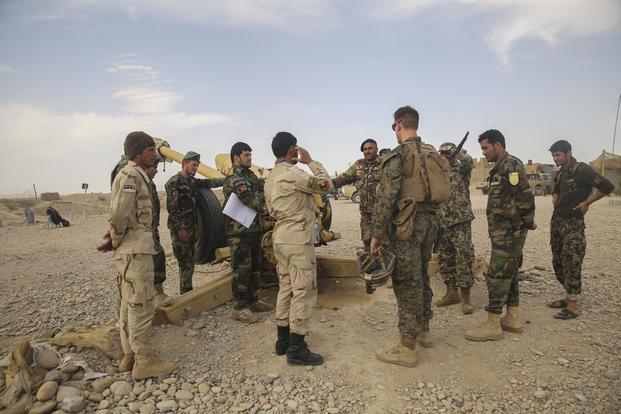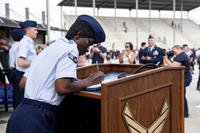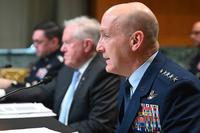After pulling out with great ceremony three years ago, Marines are back in Helmand province, Afghanistan's notorious Sangin district.
But this time, they're not there to prosecute the fight directly. Instead, they're working as advisers to the Afghan National Army as local troops work to wrest control of the district, once again, from the Taliban.
According to a Marine Corps news release published Thursday, Marines with new advisory unit Task Force Southwest partnered with ANA soldiers from 2nd Brigade, 215th Corps, to complete a five-day advisory mission at Camp Nolay, in Sangin.
It was three years almost to the day since Marines had pulled out of then-Forward Operating Base Nolay, the last remaining position in Sangin, driving long convoys of armored vehicles back to Camp Leatherneck, the Corps' headquarters in Helmand. They turned over the scant infrastructure remaining on the base, including Hesco barriers and tents, to the Afghans. At the time, Marine Corps officials on the ground said the ANA troops planned to rename the base FOB Hamidullah.
At that time, a fragile peace reigned in Sangin, purchased at high cost by Marine Corps and British troops. A third of all British casualties of the Afghan war were lost in Sangin, and about 50 Marines lost their lives there -- half of them belonging to 3rd Battalion, 5th Marines, and lost in a single, devastating 2010 deployment.
At the time of the pullout, a Marine on the ground who had been part of that 3/5 deployment, Sgt. Joe Warner, told Marine Corps Times that conditions had changed dramatically since his first visit to the region.
"As far as the populace and the atmosphere, it went from being the worst thing you could ever think of to being, like, what you'd imagine the 1950s would be in the United States in a farm town," Warner said.
But peace in the district, which has a thriving opium trade and has long represented strategic territory for the Taliban, did not last. In March of this year, multiple outlets reported that the district been captured by the Taliban, with insurgents taking over the district center.
A U.S. spokesman, Navy Capt. Bill Salvin, pushed back on those reports, saying the district center in Sangin had only been repositioned.
The recent advising trip was a chance for both the Marines and Afghan troops to assess the capabilities of the ANA's 2nd Brigade, and allowed Marines to assist in the background on a combat mission conducted by the brigade's 3rd Kandak, according to Thursday's news release.
"We are conducting an expeditionary advising package to help facilitate contact between the 215th Corps members and members of the 2nd Brigade of the 215th Corps, trying to understand each other's processes," Capt. Jonathan Pucci, a fire support adviser with the task force, said in a statement. " ... As the Afghans try to understand the battlespace, we're doing it alongside them and helping ... them build a common operational picture."
The commanding officer of 2nd Brigade, 215th Corps, Col. Abdul Waheid Tamurei, said in the release that the ANA wants to restore peace to the district and flush the enemy out, a prospect that proved daunting to the militaries of two world powers.
For the Marines, the visit allowed a firsthand look at how the Afghan unit sustained itself, allowing them to assist with logistical improvements, according to the release. At the time of the Marines' pullout in 2014, logistics was a key sticking point for the ANA, as vehicles and equipment would often break down and become useless, with no clear local repair pipeline or assurance that gear sent to headquarters in Kabul would ever return.
"I think with the leadership they're putting in place and with our advice and support, we're going to see an ANA that's supporting each other toward a common goal," Gunnery Sgt. Alberto J. Andino, a logistics adviser with Task Force Southwest, said in a statement. "The Afghans who've been putting their lives on the line and working as hard as they have been deserve a peaceful Helmand."
The 300-Marine advisory element deployed in April, replacing a Helmand-based Army unit, Task Force Forge. It was the first time Marines had formally returned to Helmand province since they departed Camp Leatherneck in late 2014.
In January, Marine Corps Commandant Gen. Robert Neller said he had "no delusions" about the challenges facing the Marine advisory element on their return.
"Are we going to change the game? I don't know; we'll find out," he said. "It's going to be a very challenging mission."
-- Hope Hodge Seck can be reached at hope.seck@military.com. Follow her on Twitter at@HopeSeck.




























